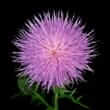Background
- Milk thistle has been used medicinally for over 2,000 years, most commonly for the treatment of liver and gallbladder disorders. A flavonoid complex called silymarin can be extracted from the seeds of milk thistle and is believed to be the biologically active component. The terms "milk thistle" and "silymarin" are often used interchangeably.
- Milk thistle products are popular in Europe and the United States for various types of liver disease. Although numerous human trials have been published, most studies have not been well designed or reported.
References
- Ladas EJ, Kelly KM. Milk thistle: is there a role for its use as an adjunct therapy in patients with cancer? J Altern Complement Med 2003;9(3):411-416.
View Abstract - Lawrence V, Jacobs B, Dennehy C, et al. Report on milk thistle: effects on liver disease and cirrhosis and clinical adverse effects. Evidence Report/Technology Assessment No. 21 (Contract 290-97-0012 to the San Antonio Evidence-based Practice Center, based at the University of Texas Health Science Center at San Antonio, and The Veterans Evidence-based Research, Dissemination, and Implementation Center, a Veterans Affairs Services Research and Development Center of Excellence). AHRQ Publication No. 01-E025. Rockville, MD: Agency for Healthcare Research and Quality. October 2000.
- Lucena MI, Andrade RJ, de la Cruz JP, et al. Effects of silymarin MZ-80 on oxidative stress in patients with alcoholic cirrhosis. Results of a randomized, double-blind, placebo-controlled clinical study. Int J Clin Pharmacol Ther 2002;40(1):2-8.
View Abstract - Madisch A, Melderis H, Mayr G, et al. [A plant extract and its modified preparation in functional dyspepsia. Results of a double-blind placebo controlled comparative study]. Z Gastroenterol 2001;39(7):511-517.
View Abstract - McCord A. Milk thistle may help improve liver health in people with HIV and hepatitis C. Proj Inf Perspect. 2008 Sep;(46):18.
View Abstract - Melhem A, Stern M, Shibolet O, et al. Treatment of chronic hepatitis C virus infection via antioxidants: results of a phase I clinical trial. J Clin Gastroenterol 2005 Sep;39(8):737-42.
View Abstract - Pares A, Planas R, Torres M, et al. Effects of silymarin in alcoholic patients with cirrhosis of the liver: results of a controlled, double-blind, randomized and multicenter trial. J Hepatol 1998;28(4):615-621.
View Abstract - Rambaldi A, Jacobs BP, Iaquinto G, et al. Milk thistle for alcoholic and/or hepatitis B or C liver diseases--a systematic cochrane hepato-biliary group review with meta-analyses of randomized clinical trials. Am J Gastroenterol 2005 Nov;100(11):2583-91.
View Abstract - Rambaldi A, Jacobs BP, Gluud C. Milk thistle for alcoholic and/or hepatitis B or C virus liver diseases. Cochrane Database Syst Rev. 2007 Oct 17;(4):CD003620. Update of Cochrane Database Syst Rev 2005;(2):CD003620.
View Abstract - Schroder FH, Roobol MJ, Boeve ER, et al. Randomized, double-blind, placebo-controlled crossover study in men with prostate cancer and rising PSA: effectiveness of a dietary supplement. Eur Urol 2005 Dec;48(6):922-30; discussion 930-1.
View Abstract - Tyagi AK, Singh RP, Agarwal C, et al. Silibinin strongly synergizes human prostate carcinoma DU145 cells to doxorubicin-induced growth Inhibition, G2-M arrest, and apoptosis. Clin Cancer Res 2002;8(11):3512-3519.
View Abstract - Velussi M, Cernigoi AM, Viezzoli L, et al. Silymarin reduces hyperinsulinemia, malondialdehyde levels, and daily insulin need in cirrhotic diabetic patients. Curr Ther Res 1993;53(5):533-545.
- Velussi M, Cernigoi AM, De Monte A, et al. Long-term (12 months) treatment with an anti-oxidant drug (silymarin) is effective on hyperinsulinemia, exogenous insulin need and malondialdehyde levels in cirrhotic diabetic patients. J Hepatol 1997;26(4):871-879.
View Abstract - Whittington C. Exacerbation of hemochromatosis by ingestion of milk thistle. Can Fam Physician 2007 Oct;53(10):1671-3.
View Abstract - Zuber R, Modriansky M, Dvorak Z, et al. Effect of silybin and its congeners on human liver microsomal cytochrome P450 activities. Phytother Res 2002;16(7):632-638.
View Abstract







